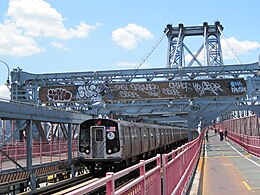Williamsburg Bridge
[6] The United States Secretary of War approved the span to Williamsburg in January 1893 under the condition that the bridge be at least 140 feet (43 m) high at its center.
[18] Schieren and New York City mayor William L. Strong agreed in April to jointly fund the bridge[19] and appoint a group of commissioners.
[31] The revisions were approved by the War Department[32] and the New York Harbor Line Board shortly thereafter, and the commissioners decided to issue $1 million in bonds to fund construction.
[74][75] The Degnon-McLean Construction Company was hired to build the Brooklyn anchorage;[76] a state judge refused to re-award the contract to a competing bidder.
[38] The commissioners finally received $200,000 that May to pay off existing debts,[101] but the city had yet to issue $4 million in bonds for the bridge's continued construction.
[149] The Roeblings requested ten months to finish the wires,[150] but city bridge commissioner Gustav Lindenthal refused to extend the deadline past April 1902.
[157] Though a local resident sued to stop Pennsylvania Steel from receiving the contract,[158] the city allowed the firm to sublease the work to the United Engineering and Construction Company.
[222] By the beginning of 1903, the Manhattan approach was still less than half complete; workers were also constructing the main span across the East River, starting at either suspension tower and progressing toward the middle.
[223] The same month, the waterproofing of the main cables was finished,[223] and the Municipal Art Commission approved some of Henry Hornbostel's proposed decorations for the bridge.
[272] In 1925, Plant and Structures commissioner William Wirt Mills announced plans to construct two vehicular roadways on the bridge for $1.5 million.
[288] An engineering report, commissioned for the city government in November 1929, suggested that an overpass be built over Clinton Street in Manhattan, and that trolley tracks on the Brooklyn side be rerouted, to reduce congestion.
[289] City alderman Stephen A. Rudd also proposed linking the Brooklyn approach to Bushwick Avenue to alleviate congestion in that borough.
[290] The trolley lines on the north side of the Williamsburg Bridge stopped running in January 1932 because the operators could not afford to repair the degraded tracks.
[311] The southern outer roadway was closed for repairs starting in April 1947,[312] and rollers under the bridge's suspension towers were replaced the same year.
[325] Inspectors found varying degrees of corrosion under the bridge's outer roadways in 1969,[326] and the approach viaducts were again repaved the next year.
[272] The city's transportation commissioner predicted that large holes would form on the outer roadways by the early 1980s if the bridge were not repaired immediately.
[337] The city announced plans to rebuild the outer roadways in early 1981,[333] and mayor Ed Koch provided $4.5 million that May for initial work on the bridge.
[346] The Karl Koch Erecting Co. received a $3.2 million contract for further repairs in early 1983,[347] and some of the main span's steel was replaced that year.
[358] Regular inspections of the bridge found that one of the main cables was decaying much more rapidly than the others; in addition, large cracks had formed on approach viaducts.
[360] Thirty engineering firms were invited in early 1988 to submit designs for a potential replacement of the span, which by then was carrying 104,000 vehicles and 85,000 subway passengers a day.
[353][355] The businessman Donald Trump offered to fix the span,[362][363] while U.S. presidential candidate Jesse L. Jackson walked across the bridge shortly after its closure.
[372] A joint venture named NAB/Koch was hired in 1990 to install new suspender cables and retrofit ungalvanized wires with rubber sheaths for $95 million.
[254] In reference to Williamsburg's large Yiddish-speaking population, a sign on the westbound approach to the bridge reads, "Leaving Brooklyn: Oy Vey!"
[412] The Brooklyn Rapid Transit Company (BRT) initially proposed extending the tracks on an elevated structure west to Bowery in 1903,[413] but these plans were canceled in 1905.
[396] The main cables are "cradled" together at the center of the span, which was intended to strengthen the bridge against wind pressure,[455] and are connected to the ends of large plate girders.
[475] At the Manhattan end of the bridge, the walkway terminated at an elevated promenade at Delancey and Clinton streets, which opened in 1914 and measured 68 by 450 feet (21 by 137 m) across.
[479] Tolls on all four bridges across the East River—the Queensboro, Williamsburg, Manhattan, and Brooklyn bridges—were abolished in July 1911 as part of a populist policy initiative headed by New York City mayor William Jay Gaynor.
[487] A plan for congestion pricing in New York City was approved in mid-2023,[488] allowing the Metropolitan Transportation Authority to toll drivers who enter Manhattan south of 60th Street.
[489] Congestion pricing was implemented in January 2025;[490] all Manhattan-bound drivers pay a toll after using the bridge, which varies based on the time of day.
[387] In 1996, artist Chris Doyle gilded the steps to the pedestrian walkway of the bridge; the project, known as "Commutable", was sponsored by the Public Art Fund.











